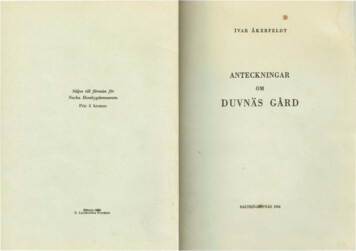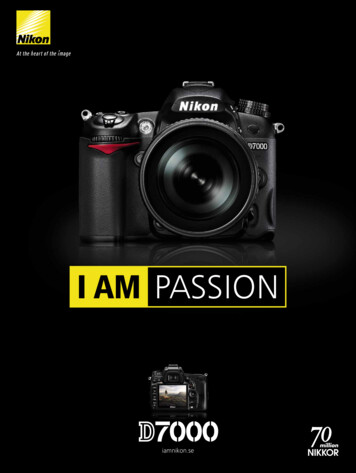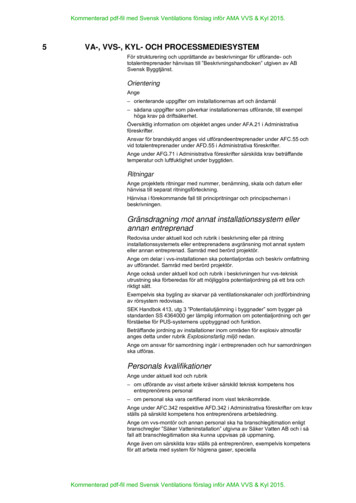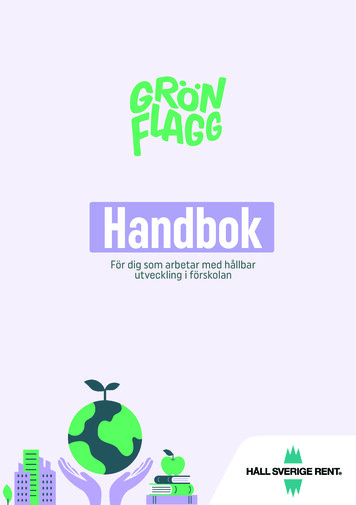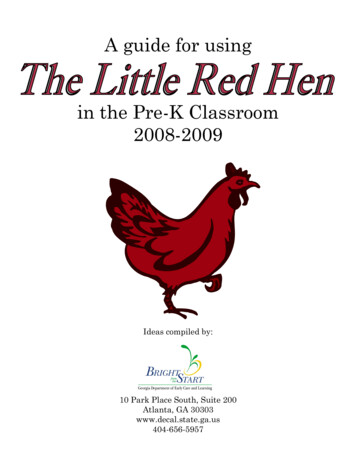
Transcription
A guide for usingin the Pre-K Classroom2008-2009Ideas compiled by:10 Park Place South, Suite 200Atlanta, GA 30303www.decal.state.ga.us404-656-5957
About The StoryThe Little Red Hen is an English folktale that has been passed on from storyteller to storyteller for many generations before it was written down. This whimsical book quickly captureschildren’s attention with its comical illustrations and descriptions of four animal friends, wholive together in a ―cozy little house.‖ The story follows a busy red hen as she tries to enlist herfriends: the dog, the cat, and the mouse, to help with chores. The little red hen works hard tokeep their home neat and tidy. When she asks for help planting some wheat, the other animalsare not interested in helping; in fact, they are not interested in the wheat until it is baked into adelicious loaf of bread! At the end of the story the animals have learned a valuable lesson: ifthey work together, they can all share in the benefits of their work.Children will enjoy the repetitive and cyclical patterns in the book, easily joining in asthe dog, cat, and mouse say ―Not I!‖ The book’s format lends itself to easily incorporating propsto help tell the story. Simple child-made masks for each of the main animal characters can beused, puppets can act out the story, and simple pieces can be created to re-tell the story on aflannel board. Encourage your children to create new endings for the story. Maybe the little redhen decides to share the bread; or maybe one of the animals helps make the bread. The possibilities are endless.Author Study - Paul GaldonePaul Galdone was born in Budapest in 1907 and immigrated to the United States in 1921.Galdone studied art at the Art Student’s League and New York School for Industrial Design. Heserved in World War II in the U.S. Army, Engineers. Galdone held various jobs including busboy, electrician’s helper, and a fur dryer, in addition to spending four years in the art department at Doubleday (NY). Galdone illustrated most of the books by Eve Titus, including theBasil of Baker Street series, which was later translated to the screen in the animated Disneyfilm, The Great Mouse Detective.Galdone and Titus were nominated for Caldecott Medals for Anatole (1957) and Anatole and theCat (1958). In 1971, those titles were named Caldecott Honor books. Galdone was known forillustrating hundreds of books and for retelling classic tales like The Little Red Hen, Three BillyGoats Gruff, The Town Mouse and the Country Mouse, and Jack and the Beanstalk.Galdone died of a heart attack on November 7, 1986, in Nyack, NY. In 1996, he was posthumously awarded the Kerlan Award for his contribution to children’s literature.
Vocabulary Development for The Little Red HenThe following are words used in the story that can be explained, noticed, developed, or acted out.Animals — characters in story (who?)Hen—adult chickenCatDogMouseWords for development ��hanging cotHousework—choresGarden hoeRipeSheaves—bundle of cut grainCake batterDelicious smellStrolledCrumbLocations (where?)Cozy little housePorchKitchenRooms in houseDiscuss where each character (animal) is in the cozy little house throughout the story.Sleeping words (what?)Sleep all day— cat—soft couchNap all day—dog—back porch—hammockSnooze all day—mouse—firesideDreaming of (what?)Sardines—small fishBoneCheeseChores (what did the little red hen do?)Cooked the mealsWashed the dishesMade the bedsSwept the floorWashed the windowsMended the clothesRaked the leavesMowed the grassHoed the gardenWheat and baking activities (why?)Plant the wheatWatered the wheatCut the wheatTook wheat to the millMade a cakeGathered the sticksMade a fire in the stoveMixed milk, sugar, eggs, butter, andflourPoured batter into shining panAte the cake
Vocabulary Development Continued Observations: Help children notice these details throughout the illustrations in the storyLadybug on wheatRake, watering canMailboxes with drawing of each animalCouch with broken springs and a brick for one legDog sleeping in hammockFly on bonePictures on mirror and mantel on fireplaceSpinning wheel to make yarnPin cushion and sewing basketOil lampWash tubWater pump in kitchen sinkClothes on line hung outsideGreen caterpillar with red headFive orange flowersSpider web with spiderGrowing wheatSun on watering canMorning glory vineSythe (sickle)Water wheelSmoke stackTea kettleWater bucketBroken leg on tableWood (sticks) for fireCaterpillar, bird, antHousecoat on mouseBroom made of sheaves of strawWheat on cake4 flowers in window sealAnimals on last pageDog sweepingCat holding dust panMouse dusting with feather duster
Language Activities for The Little Red HenCreate vocabulary cards from the story. Be sure to write the word as well as include a picture so you meet the needs of your readers and non-readers. Introduce the vocabulary cardsduring large group time and then add them to your writing center for children to use. Youmight also want to include other words about baking or n pansMuffin tinsOvenOven mittFlourSaltOilSugarTextureRecipeSliceMeasuring cupsMeasuring spoonsMixing bowlBaking panDough wlRead the book Bread and discuss the looks and textures of different types of bread. Gatherpictures/photos of pita bread, rice cakes, tortillas, loaves, muffins, etc.Bring in a variety of bread and discuss and chart some of the different types of bread. Havechildren talk about their favorite bread and different ways they like to eat it. Create a language experience chart to list children’s descriptions and comparisons of the various types ofbread.Practice writing recipes. After discussion and exploration, include some recipe cards in yourwriting center along with some cookbooks for children to explore. Ask your children, ―Whatis a recipe?‖ and discuss how following directions is critical. Have the children share some oftheir favorite foods/snacks and what ingredients they think could be in the recipe. Choose afavorite food from the group and write a recipe on chart paper as children call out the ingredients and instructions. You can also have children pretend to write their own recipe. Theteacher can take dictation and make into a class book.Cooking Activities for The Little Red HenBring in a stalk of wheat (available at Michaels stores)-discuss the foods in the grain group-discuss the value of wheat-describe the process of cutting and threshing in preparation to make bread-display other product that contain wheat and have a sampling-visit the website http://www.mypyramid.gov/pyramid/grains.htmlHave a Bread Bake! Bring in a bread machine or arrange oven use withthe kitchen. Display and discuss ingredients to be used. Create and displayword cards (mix, pour, stir, bake, and eat) and have children help sequencethe order of each step. Complete a Venn diagram comparing how the littlered hen made her bread and how your class made theirs.Everyone Helps, Everyone Eats! Tell the class you are going to make cookies, but unlike friends of the little red hen, everyone has to cooperate and
work together. Start by splitting the class into four groups. Give each group a variety ofcookie ingredients (chocolate chips, sugar, peanut butter, oatmeal) or have all of the groupsmake sugar cookies and provide various choices of decorations. Discuss materials (cookiedough, cookie cutters, rolling pin, baking pans) and list them on a chart. The chart list canalso include directions: stir the mix, spread the flour, roll the dough, use the cookie cutter tocut the dough, and place on baking pan. Discuss the sequence of steps that will be used toprepare and bake the cookies. As children are working, take photos of each of the steps asthey are engaging in them. Use the photos to make a class book and have children dictatethe story to match the photos.Take a trip to a local bakery. Contact Kroger, Publix or your localbakery for a fieldtrip or invite a professional baker to your classroom.Picture ToastPour 1/4 cup of milk in a bowl and add food coloring. Give children aslice of bread and a new paintbrush. Allow them to paint on theirslice of bread. When children are finished, toast the bread.Bread WormsMelt 1/4 cup of margarine and pour into a small bowl. Mix in one small bottle of food coloringand set aside. Divide a roll of biscuit dough into small pieces. Allow children to dip a piece inflour and roll into an ―inchworm.‖ Place on a cookie sheet and add two raisins for eyes. With asmall paint brush, allow children to paint their worm with the colored butter. Bake at 350 degrees for about 15 minutes.Irish Soda Bread4 cups whole flour2 cups white flour2 cups buttermilk1½ teaspoons baking soda1½ teaspoon saltMix all the dry ingredients together. Add just enough milk to form a stiff dough (stir with awooden spoon). With floured hands, flatten dough into a circle 1‖ to1½‖ thick on a lightly flouredbaking sheet. Make a cross in the dough with a floured knife. Bake at 425 degrees for 25 minutes; reduce the heat to 350 degrees and bake for an additional 15 minutes.Ice Cream Bread1 pint (2 cups) ice cream, softened1½ cups self-rising flourStir together ice cream and flour, stirring just until flour is moistened. Spoon batter into agreased and floured 8x4-inch loaf pan. Bake at 350 degrees for 40-45 minutes or until a woodentoothpick inserted in center of bread comes out clean. Remove from pan, and cool on a wire rack.Note: Batter may be divided evenly between two greased and floured 5x3-inch loaf pans. Bakeat 350 degrees for about 20-25 minutes or until a wooden toothpick inserted in center of breadcomes out clean.
Corn Bread2 eggs, beaten with a fork1 cup cornmeal1 cup flour1 cup milk2 teaspoons baking powder1/4 cup vegetable oil1 teaspoon salt1 tablespoon sugar1/2 cup corn (fresh, canned, or frozen if it’s taken out of the freezer ahead of time and soft)Utensils:oven (You’ll need help from your adult assistant.)forklarge bowlmixing spoonsquare baking pan (8x8") coated with nonstick sprayknifemeasuring cups and spoonsPreheat oven to 400 degrees. Put all the ingredients, except for the corn, into a large bowl. Beatall the ingredients together with a big wooden spoon. The mixture should be smooth. Stir in thecorn and mix. Pour the mixture into baking pan coated with nonstick spray. Bake in the ovenfor 25 or 30 minutes or until the cornbread is light brown on top. Remove bread from the oven,cut it into nine pieces with a knife, and serve it warm for a lip-smacking treat!Prep time: 40 minutes; Serves: 9Bread in a Bag Recipe:2 cups flour1 package Fleischman’s Rapid Rise yeast3 tablespoons sugar3 tablespoons nonfat dry milk1 teaspoon salt1 cup hot water3 tablespoons oil1 cup whole wheat flourIn a one gallon, heavy-duty freezer bag combine: 1 cup of flour, undissolved yeast, drymilk, and salt. Force air from the bag and shake to blend ingredients. Add hot water andoil and reseal bag. Mix by working with fingers. Add whole wheat flour, reseal and mix.Gradually add enough of the remaining flour to make stiff dough that pulls away fromthe bag. On a floured surface, knead dough two to four times until smooth and elastic.Cover dough with a towel and rest 10 minutes. Roll dough into a 12x7-inch rectangle.Roll up from narrow end. Pinch edges and ends to seal. Place in a 9x13 oiled loaf pan.Place pan on counter inside of an empty pan; fill with the empty pan with boiling water.Place cookie sheet on top of 9x13 pan and place loaf pan on the cookie sheet. Cover withtowel. Let dough rise 20 minutes or until it doubles in size. Bake at 375 degrees for 25minutes or until done.
Large Group Literacy ActivityAfter reading the story of The Little Red Hen, ask the children to act out the story using propsfor each character in the story. Also let the children act out the story by substituting the characters in the story with the children’s names in your classroom.Small Group Reading ActivitiesAfter reading the story The Little Red Hen in your small group:Ask open-ended questions: Why do you think the dog, cat, and the mouse would not help thelittle red hen? How do you think the little red hen felt when her friends would not help her?If you were the little red hen, what would you have done? Record the children’s answers onchart paper.Make a class-made book based on the children’s answers to the questions asked.Make a chart story by having the children retell the story in their own words.Bread, Bread, BreadRead Bread, Bread, Bread by Ann Morris (A Mulberry Paperback Book, New York, New York,1989). Show the children the cover of the book. Tell them the names of the author and the photographer. Ask them questions like:What do you think that the book will be about?Do you like bread?What kind of bread is your favorite?As you read the book to the children ask them questions such as:What shape is the bread you eat?Does your bread come in a package?Is your bread crunchy?When do you eat bread?What do you put on your bread?Why is a pizza bread?Where do you put bread at your house?Do you know anyone who makes bread?Where do you get bread?Who makes the bread in the store?
Social Emotional Learning ActivitiesDevelop a Job Chart and assign classroom jobs to children (daily or weekly). Developa plan to assign a volunteer to complete a job if a child is absent. Discuss with thechildren that sometimes we must help others in order to get a job done.Role play the story and discuss with children how they would feel if they were the little red hen.Give each child a doll cut out. Have them draw a face to represent how they think thelittle red hen felt when her friends would not help her.Let children choose a project to show caring for the community such as a clean community campaign. Families may be invited to pick up paper and trash in the schoolenvironment.Recycle materials such as newspapers, plastic bottles, and aluminum cans.Let the children participate in a beautification campaign by planting flowers or adding a bird bath on the school grounds.Invite public officials to speak to the students about their jobs as community leaders.Ask children to draw pictures and dictate sentences about ways they can help athome.Read The Little Red Hen. Pass out story character cards and list a job for each character. Explain to children that they will take turns role playing story and learn whathappens when someone does not do his or her job. Teacher will signal for a particularcharacter not to do his job. Help them conclude that if the wheat doesn’t get cut itcan’t be taken to the mill. If the wheat isn’t taken to the mill, they can’t bake bread,etc. The class will discuss how each job is important and how difficult it is to finish atask if they don’t do their part.Review The Little Red Hen. List each job that the little red hen asked for help to complete. Discuss how the little red hen responded. Now change how the little red hen responded. Have children tell which response shows self-control. The teacher can linkthis activity to the Generosity/Kindness chain below.Fingerplays and RhymesThe Little Red Hen’s Song(Tune: One, Two, Buckle My Shoe)This is the way I plant the seed, plant the seed, plant the seedThis is the way I plant the seedSo early in the morning!Repeat using the following verses in the underlined portions:Water the wheatCut the wheatGo to the millMake the doughBake the breadEat the Bread
The Little Red HenOnce there was a little red henLittle red hen, little red hen.Once there was a little red henWho found a grain of wheat.Who will help me plant this wheat,Plant this wheat, plant this wheat.We can’t help you plant the wheat,Said the little hen’s friends.We will help you eat the bread,Eat the bread, eat the bread.We will help you eat the breadSaid the little hen’s friends.Sorry, but it’s just for meJust for me and my family.Sorry but it’s just for meSaid the little red hen.Hens of Different ColorsThis little hen is BLACK (hold up blackhen)She stands in the barnyard by a big haystack.This little hen is RED (hold up red hen)She is very tired and won’t get out ofbed.This little hen is BROWN (hold up brown hen)She is feeling sad and wearing a frown.This little hen is YELLOW (hold up yellow hen)She’s friends with the rooster; he’s a handsome fellow.This little hen is WHITE (hold up white hen)She dances and plays, oh what a sight.This little hen is PURPLE (hold up purple hen)She spends her day running around in circles.This little hen is GREEN (hold up green hen)She is the silliest hen I’ve ever seen.This little hen is BLUE (hold up blue hen)She lays eggs for me and you.This little hen is PINK (hold up pink hen)She goes down to the pond to get a drink.All of these hens live at the farmOut in the big RED barn.
The Little Red Hen ChantLittle red hen works so hard,In her home and in her yard.Working, working everyday,She has little time to play.What Can a Hen Do?A hen can lay a big brown egg.A hen can stand on just one leg.A hen can run.A hen can walk.A hen can say, ―Bawk, bawk, bawk.‖But do you know what a hen can’t do?A hen can’t just like you!The ChickensSaid the first little chicken,With a strange little squirm,―I wish I could findA fat little worm.‖Said the next little chicken,With an odd little shrug:―I wish I could findA fat little bug.‖Said the third little chicken,With a small sigh of grief,―I wish I could findA green little leaf!‖Said the fourth little chicken,With a faint little moan,―I wish I could findA wee gravel stone.‖―Now, see here! Said the mother,From the garden patch,―If you want any breakfast,Just come here and scratch!‖
ChickensKnown for its feather and wings and legs,The chicken lays eggs and eggs and eggs!Known for the comb atop its crown,The chicken lays eggs of white and brown.Known for its strut when taking a walk,The chicken lays eggs! Ba-a-awk! Ba-a-awk! Ba-a-awk!My GardenThis is my garden, I’ll plant with care,Here are the seeds I’ll plant there,The sun will shine,The rain will fall,The seeds will sprout and grow up tall.The Little PlantIn the heart of a seed,Buried deep so deep,A tiny plantLay fast asleep.―Wake,‖ said the sunshine,―And creep to the light.‖―Wake,‖ said the voiceOf the raindrops bright.And it rose to see,What a wonderful,Outside world might be.Five Little SeedsFive little seeds,Five little seeds.Three will make flowers,And two will make weeds.Under the leaves,And under the snow,Five little seeds areWaiting to grow.Out comes the sun,Down comes the shower.And up comes the three,Pretty pink flowers.Out comes the sun,That every plant needs,And up come two,Funny old weeds.
I’m a Little Seed(Tune: “I’m a Little Teapot”)I’m a little seed,Brown and fat,I haven’t got a front,And I haven’t got a back.Plant me in the earth,Give me water each day,I’ll grow to be an apple tree,While you play!I dig a hole and plant a seed,Cover it with dirt, and pull a weed.Down comes the rain, and out comes thesun,Up grows my plant,Oh! What fun!The Gardener Plants the Seeds(Tune: “The Farmer in the Dell”)The gardener plants the seeds.The gardener plants the seeds.High ho the Derry-oh,The gardener plants the seeds.2nd verse: The rain falls on the ground.3rd verse: The sun shines bright and warm.4th verse: The seeds begin to grow.5th verse: Flowers (wheat) grow(s) everywhere!Little Brown SeedsLittle brown seeds so small and round,Are sleeping quietly under ground.Down come the raindropsSprinkle, sprinkle, sprinkle.Out comes the rainbow,Twinkle, twinkle, twinkle.Little brown seeds way down below,Up through the earth they grow, grow, grow.Little green leaves come one by one.They hold up their heads and look at the sun!
I Will Plant a Garden(Tune: “Old MacDonald Had a Farm)I will plant a garden green,Then I’ll watch it grow.I’ll dig some holes here in the dirt,In a nice straight row.With a dig-dig here,And a dig-dig there,Here a dig, there a dig,Everywhere a dig-dig.I will plant a garden green,Then I’ll watch it grow.I will plant a garden green,Then I’ll watch it grow.In the hole I’ll drop a seed,Then each seed I’ll sow.With a drop-drop here,And a drop-drop there,Here a drop, there a drop,Everywhere a drop-drop,I will plant a garden green,Then I’ll watch it grow.I will plant a garden green,Then I’ll watch it grow.I’ll water each plant one by one,They’ll sprout up in a row.With a squirt-squirt here,And a squirt-squirt there,Here a squirt, there a squirt,Everywhere a squirt-squirt,I will plant a garden green,Then I’ll watch it grow.I will plant a garden green,Then I’ll watch it grow.I’ll water each plant one by one,They’ll sprout up in a row.With a squirt-squirt here,And a squirt-squirt there,Here a squirt, there a squirt,Everywhere a squirt-squirt,I will plant a garden green,Then I’ll watch it grow.
Additional IdeasConvert the dramatic play area into the Little Red Hen’s Bakery. Let the children help youmake a sign for their bakery. Combine your play dough with bowls, wooden spoons, cookie cutters, and measuring cups and let the students pretend to make dough. Add in other bakingitems as suggested below.Bakery Prop Box Ideasplay doughmeasuring spoonsapronoven mittschef hatmuffin tinsmixing spoonscookie cuttersempty boxesrecipescupcake linerspictures of baked goodsorder padspenstin cansLittle Red Hen Prop Boxmasks for charactersbaking materialsrolling pinscookie sheetscake panssiftercook bookssigns for costsplay moneywheat stalkwatering canhoeseedsWebsites for Little Red Hen mlmeasuring cupsdrying rackmixing bowlsempty spice bottlesflour shakercash registerempty baking containersgardening glovesphotos from story
Changes to Learning AreaTOPIC: The Little Red HenHouse/Dramatic PlayApron, masks for characters from the story, baking items (differentsized mixing bowls, spoons, baking pans, measuring cups, etc.) and―Little Red Hen‖ prop boxToys/Puzzles/MathConcentration Memory Game – Sequencing cardsBirthday Cake Game – Count candles on felt gamePuffed Wheat CerealBlocksCreate blocks with characters from the story:barnboots, gloves, straw hats, overalls, tin pails, plastic rakes, andhoessticks for fencingfarm animalsReal and found materials: Wheat or HayArtCorn Cob PaintingMake paint brushes out of bundles of hayMake a cake out of a cardboard circle and decorate with collage materialsReal and found materials: Measurement cups and seeds to sortMusic―Old McDonald‖―BINGO‖―The Little Red Hen‖ songLittle Red Hen Says (Simon Says)Books for current topic or themeCompare and Contrast different versions of ―Little Red Hen‖ListeningRecord parents reading ―The Little Red Hen‖, so children can listen tothe story. Take a picture of the parent reading the story and placenear the listening center so children will know who the guest reader is.Books representing cultures, abilitiesComputerSciencewheat grass seeds to plantbread Comparison (variety of breads)growing corn from kernelsvariety of meal (flour, corn meal, wheat germ, etc.)compare different feathers—duck, chicken, turkeysFlannel BoardCreate flannel board pieces from the story so children can practiceretelling the story. You can trace characters from the book using Pelonmaterial found where fabric is sold.Cooking ExperiencesBake bread or cakeMake butterWriting/LanguageAdd vocabulary cards related to the story, recipe cards and recipebooks.Chart repetitive words from storyCreate ―I Can Help‖ coupons for parentsSensory TableAdd in baking items such as sifter, measuring cups, measuringspoons, and mixing bowls.Weekly large group literacy activity:Retell the story using props. Alternate different beginnings and endingsSocial StudiesChart a story about working togetherWhere does wheat grow? Does it grow better in specific parts of Georgia?OutsideTake turns kicking a ball back and forth with a friendParachute (working together)
Farm Ideas(A continuation of ideas that could carry over after reading The Little Red Hen)Compiled by:
Creative ExpressionCorn Cob PaintingMaterials: Paint, paper plates, paper, and a corncobDirections: Put paint on paper plates. Have the children dip the corncob in the paint and then paint designs onthe paper. Encourage children to use the side of the cob and roll designs. Let the children dip the top of the cobin the paint and discover what designs they can make using only the top.WSS Indicators that might be documented include: PDH B1 and B2, TA A3, and PS C1Thumbprint AnimalsMaterials: Paper, pink paint, red paint, black paint, and markersDirections: Have children put pink thumbprints on a piece of construction paper and make the prints intopigs. Use black paint for cows, red for roosters etc. Let children use markers to add legs, beaks, etc. Encouragechildren to think of other animals they could design.WSS Indicators that might be documented include: PS C3, TA A3, and PDH B3Barnyard MuralMaterials: A long sheet of butcher paper, paint, a paintbrush for each child, markers, or crayonsDirections: Draw a barn and the surrounding barnyard on the butcher paper. Allow children to draw or painttheir favorite barnyard animal. For an added touch, have them dictate what sound their farm animal makes onthe mural.WSS Indicators that might be documented include: PS D2 and D3, LL A3, D1 and D2, TA A3, and PDH B3Farm Weaving IdeaMaterials: Chicken wire, tape, natural raffia, gingham ribbon, old blue jeansDirections: Cut squares of small-holed chicken wire. Put masking tape around the sharp edges. Spread out assorted lengths of natural raffia, gingham ribbons and narrow strips ripped from old blue jeans. The children canweave them in and out of the holes.WSS Indicators that might be documented include: PDH B1 and B2, and TA A3Stick HorsesMaterials: Wrapping paper tubes, wooden dowel rods, horse head stencils, collage materials (yarn, wiggly eyes,ribbon, faux fur, etc.), butcher paper, paint, crayons, and markers.Directions: Use long tubes from wrapping paper or wooden dowel rods. Supply stencils of horse heads and pictures of horses along with large pieces of paper (butcher paper will be sturdy and work the best), collage. Be surechildren add a long neck for stuffing into the tube. Have children trace using the stencils or draw their own whilelooking at pictures. They can then paint or color and then cut out horse heads. Stick the long neck into the wrapping paper tube or dowel rod and secure with rope, ribbon, or yarn. Teachers, you might have to secure the headand neck with a little hot glue or staples.WSS Indicators that might be documented include: PDH B1, B2 and B2, and TA A3Crayon RubbingsMaterials: Items for rubbings: feathers, straw, corn husk, crayons, paperDirections: Ask children to place an item under the paper and rub over it with crayons. An imprint of the itemwill show through paper.WSS Indicators that might be documented include: PDH B1 and B2, ST A1, and TA A3Sponge PaintingMaterials: Purchase or cut out sponges of farm animals, tempera paint, and paperDirections: Have children place sponges in paint and place on paper creating their own farm design.WSS Indicators that might be documented include: TA A3 and PDH B2 and B3Hay Bundle PaintingMaterials: Small bundles of hay, paint, and paperDirections: Tie small bundles of hay together to form paintbrushes, allow children to paint at the easel or at thetable with them.WSS Indicators that might be documented include: TA A3 and PDH B3
LanguageFarm MuralMaterials: Farming magazines, glue, scissors, butcher block paperDirections: Ask children to look through magazines to choose and cut out pictures. Glue the pictures onto a largesheet of butcher block paper. Then write the words or sentences they dictate on the mural.WSS Indicators that might be documented include: PDH B3, LL B1, B2, D1, and TA A3Word WallMaterials: Magazines, pictures, index cardsDirections: Create a word wall with pictures and words of items found on a farm. Post in an accessible location forchildren’s use.WSS Indicators that might be documented include: LL C2, C3, and D2Concentration/Memory GameMaterials: Matching sets of animal pictures or pictures of adult animals and their young.Directions: Laminate the pictures and place them face down on the table. Turn them over in sets of two untilmatches are made.WSS Indicators that might be documented include: MT C1, ST A3, and LL B1 and B2Retell the EndingMaterials: Chart paper, markerDirections: Predict a new ending to the story – What if no one helped the Little Red Hen?WSS Indicators that might be documented include: LL A1, B1 and B2, C1 and C4, and PS C3Act Out the StoryMaterials: Costumes/masks designed for the storybook characters in ―The Little Red Hen‖Directions: Have children pretend to be the different characters and act out the story.WSS Indicators that might be documented include: LL A1, C1 and C4, TA B2, and PS D3Farm GuessingMaterials: Small plastic farm animals (adults and their young)Directions: Match the animals – adult animals with their young. Use correct terms in identifying the animals. Forexample, the mother sheep is a ewe, and the baby is a lamb.WSS Indicators that might be documented include: LL B1 and B2 and PS D1MudMaterials: Water, dirt, mixing bowl, large freezer bagsDirections: Ahead of time, mix water and dirt to form some thick mud. Divide the mud among several zipper-topfreezer bags and close the top of each bag. Have the children practice printing numbers, letters, words, or drawinganimals in the mud. Show them how to smooth the mud out so they can make new numbers, letters, etc.WSS Indicators that might be documented include: LL C3 and D2, PDH B1 and B2MathGuess the NumberMaterials: Cut out of a sheep on a poster board, large marshmallows or cotton balls, glue, and chart paperDirections: Draw an outline of the sheep on the poster b
Cat (1958). In 1971, those titles were named Caldecott Honor books. Galdone was known for illustrating hundreds of books and for retelling classic tales like The Little Red Hen, Three Billy Goats Gruff, The Town Mouse and the Country Mouse, and Jack and the Beanstalk. Galdone died of a heart attack on November 7, 1986, in Nyack, NY.








